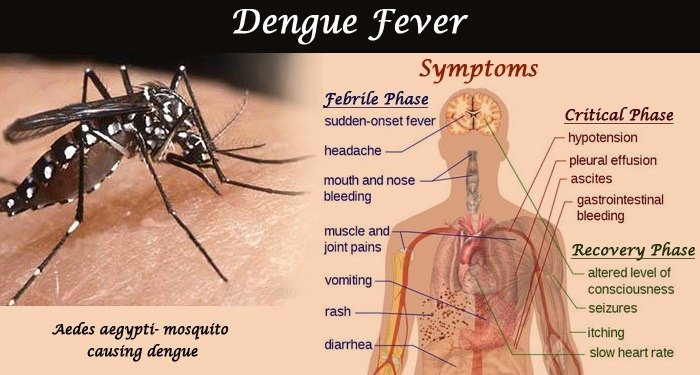
Dengue Fever
Dengue fever is also known as breakbone fever. Dengue fever is caused by a virus named dengue virus (DENV). It is transmitted by female mosquito bites an Aedes widely disperse in subtropical and tropical areas of the world.
The most common symptoms are fever, body pain, and hemorrhage from the mucus membrane of the body.
Causes: DENV (dengue fever virus ) is an RNA virus and is spread by female mosquito bites named Aedes.
Transmission: dengue virus is transmitted by mosquito bites. They usually bite in the early morning or in the evening. Primarily humans mostly harbour dengue viruse.
Infection can be occurred by a single bite when a mosquito bites an infected person they get infected too with the virus. An infected mosquito remains infected throughout his life and spread the infection to the human being.
Symptoms:
â— The onset of symptoms usually occurs after 3 to 14 days
of infection.
â— The most common symptoms are fever, joint pain or
haemorrhage from the mucus membrane of the body.
â— Skin eruptions.
â— Breakbone fever is another name for dengue fever.
â— There are 3 stages of fever:
1. Febrile phase.
2. Critical phase.
3. Recovery phase.
Febrile phase: High fever over 104 degrees Fahrenheit accompanied by body pain, headache which lasts for 2 to 7 days.
â— Nausea vomiting may also occur.
â— Red flushed face.
â— Skin rashes
â— Mild bleeding from the mouth and nose.
Critical phase: Critical phase mainly occurs in children and young adults. In a critical phase, when fever gets resolved plasma leakage increases from the blood vessels that causes excessive bleeding from the mucus membrane of the body. Bleeding from the eyes, nose, ears etc. It lasts for 2 days. Pain in the chest and abdomen with an accumulation of fluid.
Recovery phase: The recovery phase lasts for 3 days. In the recovery phase, plasma reabsorbed in the bloodstream. Severe itching and bradycardia can occur in this stage.
Unconsciousness and seizures due to accumulation of
fluid in the brain.
Diagnosis: preliminary diagnosis is based on patient clinical features.
Laboratory finding:
â— Low white blood cell count.
â— Low platelet count.
â— Increased creatinine level.
â— Increased hepatic transaminase level.
â— Serum plasma test to detect virus, viral nucleic acid, or
virus-specific IgM and neutralizing bodies. IgM is detected after 5 days to a month after the onset of symptoms.
Preventions :
â— Preventive vaccines are available but the vaccine is only
given to the patient prior history of dengue.
â— Best way to prevent it to prevent mosquito bites by the
following methods:
Use mosquito repellent.
Wear full sleeves and long pants.
Use mosquito net while sleeping.
Use an air conditioner if available.
Do not let water collect anywhere. Turn over, cover or
throw out items that hold water.
â— Baptisia: well indicated for dengue fever with body pain
and stiffness of the neck and drawing pain in arms and legs. Fever with chill and rheumatic pain and soreness all over the body, chill around 11 am.
â— Eupatorium perfoliatum: It is given in patients having fever with bone pain in the body. Decreased platelets count that causes hemorrhages and weakness. Soreness feeling in the arms and in the bones and muscles. Fever with chill between 7-9 am, preceded by thirst. Great soreness and aching in the body.
â— Rhus tox: it has wonderful results in dengue fever with chill and red vesicular eruptions, acts well in the joint pain in the febrile phase. Restlessness and trembling in fever.
â— Carica papaya: it is well indicated in fever with enlarged liver and spleen associated with indigestion and weakness. Pain in the right hypochondriac region. Intolerance of milk even small quantities cause indigestion